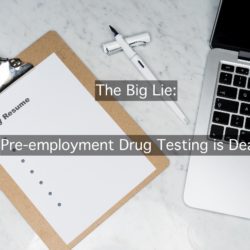This information is provided for educational purposes only. Reader retains full responsibility for the use of the information contained herein.
Back in the late 1980s there were a series of public service announcements calling cocaine the “Big Lie.”[i] They were intended to counter the disinformation going around about cocaine—it was not addictive, it made users more productive, everyone was doing it. All lies. Around that same time there were a lot of lies and misrepresentations circulating about workplace drug testing. Similarly, in 2020 disinformation about workplace drug testing, and now legal marijuana is still prevalent.
The federal government reported in its 2019 annual “Survey on Drug Use and Health” that the number of illicit drug users age 12 and older increased from 53.1 million in 2018 to 57.2 in 2019.[ii] That’s a lot of drug users and a huge increase in a 12-month period. But since the COVID-19 pandemic began, experts agree that substance has increased dramatically. So startling is the pandemic’s impact on the levels of substance abuse that recovery expert Tim Ryan refers to it as the “pandemic within the pandemic.”[iii]
Combine those statistics with the rapid, almost astronomical rise in unemployment during the first months of the pandemic followed by a more recent and almost equally astounding drop in unemployment.[iv] All of this means that a lot of today’s job seekers were likely using illicit drug and misusing legal drugs, like marijuana, during their forced period of unemployment. Conclusion: Pre-employment drug testing has, perhaps, never been more important than right now.
The United States Postal Service Study
Drug testing works as a powerful deterrent to drug use and as an effective way of identifying people who need help. And it can safely be said of pre-employment testing, that it is the most popular and probably most effective form of drug testing.
Perhaps the most compelling study ever conducted on the impact of substance abuse on the workplace had to do with pre-employment drug testing. This study was published clear back in 1989, but it’s as relevant today as it was then. The U.S. Postal Service (USPS) initiated a major pre-employment drug testing study sponsored by the federal government. The purpose of the study was to determine the relationship, if any, between drug use and job performance.
USPS tested 5,465 applicants between September of 1987 and May of 1988. Of the 4,375 applicants who were hired, 395 had tested positive (63% for marijuana, 24% for cocaine, and 11% for all other drugs combined). No one in the Postal Service was aware of the test results except those conducting the study.
After 1.3, 2.4 and 3.3 years the Postal Service noted remarkable differences between the “test-positive” group and those that had tested negative:
- Involuntary Turnover—At the 1.3-year mark, 15% of the test-positive group had been terminated. That represented a 47% higher rate than the test-negative group. At 2.4 years the rate was 69.4% higher; at 3.3 years the rate was 77.4% higher.
- Absenteeism—After 1.3 years the test-positive group was 59.4% more likely to be heavy users of leave. Those who tested positive for cocaine were 4 times more likely to be heavy leave users; those who tested positive for marijuana were 1.5 times more likely to be heavy leave users. After 2.4 years the positive testers were absent almost 10% of the total work hours scheduled; at 3.3 years they were absent 11% of the scheduled work hours.
- EAP—After 3 years of employment 14% of the test-positive group had been referred to the company’s employee assistance program (EAP) compared to just 7% of the test-negative group. If the EAP identified an alcohol problem the referral rate was 3.5 times higher; if a problem with illicit drugs was identified the referral rate jumped to 5.7 times higher. Interestingly, the referrals rate between the two groups for emotional, marital, or stress-related problems was virtually the same.
- Disciplinary Actions—The test-positive group had a tendency to face disciplinary action more often than the test-negative group. At the 3.3-year mark, 37% of the test-positive group had been disciplined compared to 19% of the test-negative group.
USPS projected what it would have saved millions of dollars if it had avoided hiring members of the test-positive group in the first place. The report found that UPSPS would have saved approximately $52 million by 1989 if it had not hired the known drug users in 1987—in just 2 years! By 1991 the estimated savings would have increased to $105 million.[v]
Current State of Pre-employment Testing
Pre-employment screening is the number one method of drug testing compared to the various other forms of employee testing (random, post-accident, reasonable suspicion, etc.). One major drug testing laboratory estimated that 65% of all workplace drug tests are pre-employment screens. That is in part because several federal government agencies, including the U.S. Department of Transportation (DOT), mandate certain public and private sector employers to conduct pre-employment testing. Some states that offer workers’ compensation premium discounts to employers who conduct drug testing often require pre-employment drug testing.
Generally speaking, job applicants have fewer rights than existing employees when it comes to employment screening requirements, including drug testing. Additionally, pre-employment drug testing is typically outside the parameters of collective bargaining agreements. And aside from a few states that have legalized marijuana and placed limited conditions on pre-employment testing for THC, pre-employment drug testing is legal in every state, even the states that place restrictions on other forms of drug testing like random testing.
Given all of that—the cost of substance abuse, the recent dramatic increase in substance abuse, and the relative ease of implementing and maintaining a pre-employment testing policy—every employer should have a pre-employment drug testing program in place, right?
The Most Compelling Reason
Perhaps the strongest vote in favor of pre-employment drug testing is found in a study conducted by the federal government of its own annual drug abuse survey (formerly known as the U.S. Household Survey on Drug Abuse). The survey identified regular drug users as either employed or unemployed. The employed drug users were asked a series of questions specific to their employment (e.g., Does your employer drug test? What type of testing are you subject to? How many employers have you had in the past year?).
When the regular drug users who were employed full-time were asked if they were more likely or less likely to work for a company that conducted drug testing, the answers were beyond even what most experts would have predicted—30% admitted that they were less likely to work for a company that conducted pre-employment screening… 30%![vi]
This is a clear indication that drug users hate pre-employment drug testing, which provides the strongest argument in favor of a pre-employment testing program.
Implementing Pre-employment Testing
If you’re convinced that it’s a smart business move to conduct pre-employment testing, the first question is where do you start? Following are some basics to get your started:
First, it is critical that employers understand how the Americans with Disabilities Act (ADA) affects pre-employment screening for drugs and alcohol. Because current alcohol abusers are a protected class under the ADA, the Equal Employment Opportunity Commission (EEOC) considers an alcohol test to be a medical exam and restrictions apply. Unless otherwise mandated to do so by a state or federal regulation, employers are well-advised not to conduct pre-employment alcohol testing. Pre-employment drug testing, on the other hand, is not restricted by the ADA. Visit the Equal Employment Opportunity Commission website for full details.[vii]
Second, if your company employs workers who perform certain safety-sensitive transportation duties, you may be required to conduct DOT-mandated pre-employment drug testing. These regulations are very clear and covered employers must comply or face the possibility of penalties.
Keep in mind that there are other DOT agencies and other federal agencies like the Nuclear Regulatory Commission and the Department of Defense that have with their own drug testing regulations. Find more information about DOT requirements at the website for the Office of Drug & Alcohol Policy & Compliance.[viii]
Third, every state permits pre-employment drug testing, but some apply conditions that employers must observe. Be aware that there are states with mandatory drug testing laws that apply to all employers that wish to conduct pre-employment testing. Minnesota, for example, requires pre-employment testing of all applicants. Employers must notify applicants in writing if an offer is withdrawn because of a positive test result. Other states have similar restrictions around pre-employment testing.
There are also states with voluntary laws that only apply to certain employers. Alabama, for example, limits pre-employment testing to applicants for certain positions. However, it is very important to note, that outside of this and other voluntary state drug testing laws there may be no restrictions on pre-employment drug testing.
Fourth, pre-employment drug testing should only be conducted once a “conditional” offer of employment has been extended. This is sometimes referred to in state statutory language and elsewhere as “post-offer” pre-employment testing. There are 15 states that require this by law, though it is a safe practice to ensure compliance with ADA requirements.
Return on Investment
Let’s get back to the bottom line. Measuring return on investment (ROI) can be done in many ways, depending on a company’s drug testing objectives. An easy way to do it regarding pre-employment drug testing is by tracking the cost of drug testing against the cost of drug abuse.
Based on the following assumptions we can build a simple ROI model:
- Let’s assume the cost of each substance abusing employee is approximately $7,000 per year.
- Let’s also assume that about 15% of the workforce has a substance abuse problem.
- And that about 4% of all pre-employment drug tests are positive.
Using these figures let’s estimate the cost of drug abuse for a company with 500 employees. This company has a turnover rate of about 15% which means they hire 75 new employees every year. If 15% of this group (the percentage of the workforce with a substance a problem) or 11 new workers were hired at an average cost of $7,000 per year due to substance abuse, the company would be taking on total extra costs of $78,750 annually. This cost would be traceable in lost productivity, workers’ comp claims, health care costs and other substance abuse-related costs including the cost of replacing such workers.
However, if the company conducts pre-employment drug testing, they could avoid hiring the 11 substance abusers. The cost to conduct 75 pre-employment drug tests at an average per test price of $40 would be $3,000. In other words, if this company spends $3,000 on pre-employment drug tests, they could save about $75,000 (the extra cost of substance abuse minus the cost of drug testing). That’s an ROI ratio of 25-to-1… $25 saved for every $1 spent.
Play with the percentages, lower the total number of drug tests conducted or the percentage that test positive, or increase the cost of each drug test, etc. No matter how you figure it pre-employment drug testing is worth every dollar spent and much more.
Conclusion
Harkening back to the late 1980s one last time, it was quite common to hear proponents of drug testing claim that pre-employment testing was a “liquid I.Q. test” for job applicants. Their reasoning was that if someone knew ahead of time they were going to be tested and still showed up for a job interview with drugs in their system they were not smart enough to get the job.
However, when you take into account the number of people who abuse drugs, the cost per substance abuser, and the relatively low cost of screening job applicants for drugs, pre-employment drug testing is not an I.Q. test for drug users, it’s an I.Q. test for employers. Pre-employment drug testing is the proverbial “no brainer.”
© 2010-2020 The Current Consulting Group, LLC – No portion of this article may be reproduced, retransmitted, posted on a website, or used in any manner without the written consent of the Current Consulting Group, LLC. When permission is granted to reproduce this article in any way, full attribution to the author and copyright holder are required.
[i] The National Institute on Drug Abuse. “Cocaine. The Big Lie.” YouTube, 1986.
[ii] National Survey on Drug Use and Health. Substance Abuse and Mental Health Services Administration. https://www.samhsa.gov/data/report/2019-nsduh-detailed-tables
[iii] “A Pandemic within a Pandemic: Substance Abuse Rises Amid COVID.” EHS Today. June 18,2020. https://www.ehstoday.com/health/article/21134240/a-pandemic-within-a-pandemic-substance-abuse-rises-amid-covid
[iv] The Employment Situation — August 2020. Bureau of Labor Statistics. https://www.bls.gov/news.release/pdf/empsit.pdf
[v] An empirical evaluation of preemployment drug testing in the United States Postal Service: interim report of findings. Eds Steven W. Gust, Ph.D. and J. Michael Walsh, Ph.D. Rockville, MD: National Institute on Drug Abuse, 1989. Pp. 111-137.
[vi] Why Drug Testing. William F. Current. WFC & Associates. 2008. P. 34.
[vii] http://www.eeoc.gov/policy/docs/preemp.html
[viii] http://www.dot.gov/odapc



